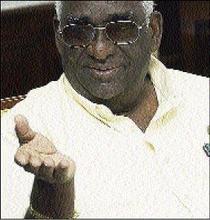John Myers Jr.. Business Reporter

Dr Henry Rainford, managing director and CEO of the Jamaica Livestock Association. - File
Jamaica Livestock Asso-ciation's (JLA) pre-tax losses of $12 million were largely the result of spiralling costs for corn, soybeans and wheat on the international market, the company has said.
Its losses after tax was $13.46 million - a wide swing from $11.7 million of profit in 2005 - despite increased revenues of $1.15 billion, up from $1.13 billion.
JLA's increased turnover was eroded by a 9.5 per cent increase in expenses and 17.9 per cent higher finance costs.
With grain prices still climbing on the world market, JLA managing director Dr. Henry Rainford is forecasting that the company will chalk up another loss-making year.
The company has already recorded pre-tax second quarter losses of $1.1 million, and for the six-months to May 31, its pre-tax losses are $857,000.
The company's financial year end is in November.
Rainford said the sharp reduction in cattle inventory, which has moved from over 350,000 heads 10 years ago to under 50,000 currently, has resulted in lower demand for JLA's products.
That, coupled with the rising costs for raw material used primarily to manufacture animal feed, has created a huge dent in the company's profits.
According to its annual report, the livestock sub-sector declined overall in 2006 by 7.6 per cent.
The total weight of animals slaughtered also fell from 122.115 million kilogrammes in 2005 to 118,11 million kgs in 2006.
Price increases
Rainford said the growth in revenues was largely the result of price increases in products sold through its chain of retail agricultural stores.
"The population of cattle has been reduced to under 50,000 heads ... so that would impact on the amount of goods we supply to the beef and dairy industries, because we were geared to service them so there is less demand for my products," Rainford told Wednesday Business at the company's annual general meeting held at its head office in Newport East, Kingston.
"The price of corn and soya, in fact all grain prices, have increased significantly. We used to pay somewhere in the order of about US$200 per metric tonne for soya bean; today it is over US$340 per metric tonne," he said.
Similarly, he said the price for corn two years ago was about US$100 per metric tonne, but now it is about US$240.
Wheat, which they use to mix with corn and Soya bean in the manufacture of animal feeds, has gone up from J$5,000 per tonne to over J$11,000 per tonne.
The wheat is purchased locally from Jamaica Flour Mills.
john.myers@gleanerjm.com

